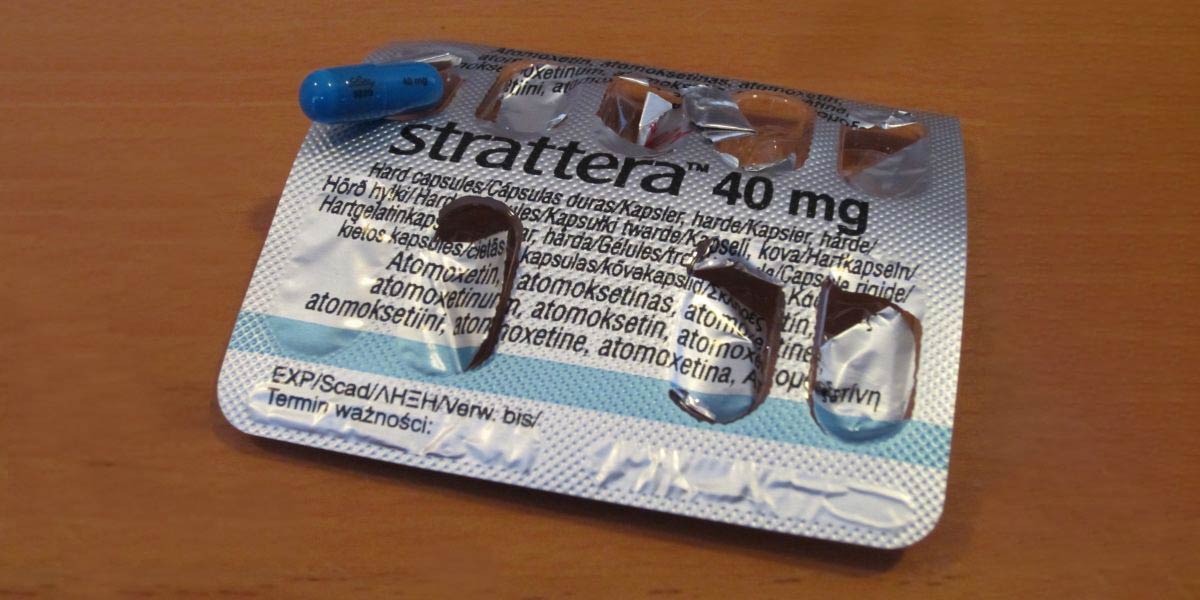What’s the Difference Between Adderall and Strattera?

Despite targeting the same disorder, Adderall and Strattera are the two most commonly prescribed medications to treat attention deficit hyperactivity disorder (ADHD).
Managing adult ADHD can be challenging and often involves a trial-and-error method with ADHD medications. In some more severe cases, doctors may simultaneously prescribe Strattera and Adderall, adjusting the dosages as needed.
What Is Strattera?
Strattera, the brand name for atomoxetine, is a selective norepinephrine reuptake inhibitor (SNRI), a category it shares with antidepressants. Occasionally, doctors prescribe it off-label for conditions beyond its usual use.
Strattera stands out as one of the few non-stimulant prescription medications available for ADHD treatment. It regulates the brain’s use of norepinephrine, a chemical crucial for focus, attention, and nerve signals in the central nervous system.
Norepinephrine is important for the central nervous system’s focus, attention, and nerve signals. The brain regulates the use of norepinephrine. Norepinephrine is a key chemical for focus, attention, and nerve signals.
Strattera is available in oral capsules, with 10 to 100 MG dosages to suit patient needs. Since Strattera has a long duration in the body, it does not require an extended-release formulation. You must take it consistently at set times to maintain its effectiveness.
Strattera is less addictive than stimulant medications for ADHD, but it can still cause psychological dependence and abuse. Before stopping Strattera, talk to a doctor about slowly reducing the dose. It’s not safe to suddenly stop taking the medication.
Adderall vs. Strattera
Strattera and Adderall are both approved by the Food and Drug Administration (FDA)to treat ADHD in people of all ages. Strattera is not a stimulant.
Beyond their shared goal of treating a medical condition, the similarities between the two medications stop there.

Adderall
- A well-known blend of dextroamphetamine and amphetamine
- Acts as a stimulant
- Classified as a Schedule II controlled substance
- Instant effect
- High risk of misuse and dependency
- No mandatory daily dosage
- Accessible in the form of immediate-release oral Adderall tablets or Adderall XR (extended-release)
- Gradual reduction is required if stopping regular use
- Risky interactions with alcohol and other drugs
- Not safe for use during breastfeeding
Strattera
- Atomoxetine’s proprietary brand name
- Not a stimulant drug
- Not classified as a controlled substance
- Takes a few days or weeks to show effectiveness
- Minimal risk of misuse and dependency
- Needs to be taken daily
- Only available as an immediate-release oral capsule on prescription
- A gradual stop of taking the medication is required
- Risky interactions with alcohol and drugs
- Not safe for use during breastfeeding
While stimulants such as Adderall are widely recognized for their rapid and effective treatment of attention disorders, Strattera remains a viable alternative for people who experience severe reactions to Adderall or possess a history of substance abuse.
Adderall helps attention disorders quickly. Strattera is an alternative for those who can’t use Adderall or have a substance abuse history.
In certain instances of ADHD that do not improve with a single medication, doctors may prescribe a combination of Strattera and Adderall.
It’s important to tell your doctor about any positive or negative effects of the drugs you are taking. This will allow appropriate dosage modifications.
ADHD Medication Side Effects
Although Strattera and Adderall operate through different mechanisms, they exhibit some shared side effects due to their chemical interactions.
Both Strattera and Adderall have common side effects, including:
- Feeling lightheaded
- Perspiration
- Dry mouth
- Lowered libido
- Loose stools
- Loss of appetite
- Migraines
- Feeling sick
- Irregular heartbeat
Long-term side effects common to both medications include:
- Dependence and addiction
- Kidney damage
- Liver disease
- Heart problems
- Slowed growth in children and adolescents
- High blood pressure
For people with existing mental health issues, both medications may exacerbate conditions such as depression and anxiety. Typically, most side effects diminish as one adapts to the medication, allowing doctors to modify dosages as needed. Nevertheless, due to their distinct mechanisms of action, Strattera and Adderall each possess unique side effects.
Strattera Side Effects
Strattera needs time to reach adequate levels in the body, and side effects might intensify as the medication accumulates.
Typical side effects of Strattera include:
- Tiredness
- Stomach cramps
- Irregular bowel movements
- Excessive gas
- Trouble in passing urine
- Emotional fluctuations
- Sudden warmth
- Numbness in limbs
- Acid reflux
- Muscular discomfort
- Intense dreaming
- Alterations in sleep rhythm
- Sexual dysfunction
It is important to note that children and adolescents taking Strattera have reported an increase in suicidal thoughts and behaviors. Take alterations in mental well-being or conduct seriously and seek professional assistance.
Adderall Side Effects
Adderall tablets start working quickly, especially the immediate-release kind. Side effects of Adderall XR may last longer than the immediate-release form.
Side effects of Adderall include:
- Insomnia
- Increased body temperature
- Weight loss
- Runny nose
- Reddening or blotchy skin
- Elevated blood pressure
- Skin eruptions or welts
- Restlessness
- Muscle spasms or twitching
More and more young adults are abusing prescription stimulants like Adderall, which can quickly result in an overdose. If you take too much Adderall, the symptoms can be like its bad side effects. It’s important to get medical help immediately if these symptoms are too much or dangerous.

ADHD Treatment Options
While medication can effectively treat ADHD, individuals may develop a tolerance over time, reducing its efficacy. Furthermore, some individuals might steer clear of prolonged medication usage because of worries about dependency or the danger of forming a substance abuse problem.
The most effective way to manage ADHD is to address the underlying causes and behaviors. This can be done through proven therapies and exercises, which have been shown to have long-lasting results. Cognitive Behavioral Therapy (CBT) can help reframe thought patterns and coping mechanisms related to ADHD, while individual therapy can address the emotional challenges associated with living with ADHD.
Treatment for Prescription Drug Abuse at White Oak Recovery
More and more people are becoming addicted to prescription medications like Strattera and Adderall. They use these drugs to self-medicate for ADHD and other conditions. Still, there are more efficient methods to handle addiction and concurrent mental health issues than resorting to the misuse of medication.
At White Oak Recovery Center (WORC), we address both the physical effects of addiction and the underlying reasons for substance abuse. Our approach is comprehensive and caring. We focus on treating the whole person, not just the symptoms. Our goal is to help you overcome addiction and any related issues.
Our treatment center provides a peaceful environment for you to focus on addressing the root cause of your addiction. We don’t just treat the symptoms. Here, you can learn healthy habits and coping skills to prevent relapse.
At WORC, we provide an on-site medical detox program. Our licensed and compassionate staff provide 24/7 medical supervision. This helps you safely manage withdrawal symptoms.
Our goal is for you to feel empowered during this process. When you start treatment, our caring experts will create a unique plan to fit your needs and goals. It will focus on your needs and goals to help you recover successfully.
Reach out now. Initiate the recovery journey to regain control of your life. Our treatment specialists are ready and eager to provide help with the right treatment for you.

Am I covered for addiction treatment?
Your insurance may cover treatment. Call now for an entirely free and confidential assessment. Recovery starts with a phone call.

- Childress, Ann C., “A Critical Appraisal of Atomoxetine in the Management of ADHD.” Therapeutics and Clinical Risk Management, Dec. 2015.
- Upadhyaya, Himanshu P., et al., “A Review of the Abuse Potential Assessment of Atomoxetine: A Nonstimulant Medication for Attention-Deficit/Hyperactivity Disorder.” Psychopharmacology (Berl), Feb. 2013.
- Elia, Josephina, “Attention Deficit/Hyperactivity Disorder.” Psychiatry (Edgmont), Jan. 2005.
- Treuer, Tamas, et al., “A Systematic Review of Combination Therapy with Stimulants and Atomoxetine for Attention-Deficit/Hyperactivity Disorder, Including Patient Characteristics, Treatment Strategies, Effectiveness, and Tolerability.” Journal of Child and Adolescent Psychopharmacology, Apr. 2013.
Medical Disclaimer:








